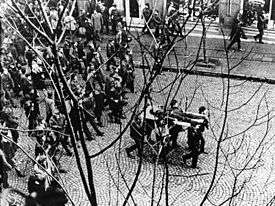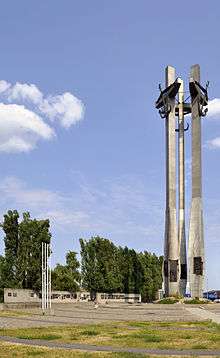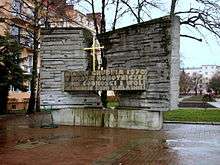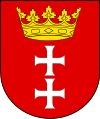Polish protests of 1970
The Polish 1970 Strikes (Polish: Grudzień 1970, "December 1970") occurred in northern Poland in December 1970. The protests were sparked by a sudden increase of prices of food and other everyday items. As a result of the strikes, which were put down by the Polish People's Army and the Citizen's Militia, at least 42 people were killed and more than 1,000 wounded.
| Polish 1970 Strikes | |||
|---|---|---|---|
 Polish 1970 Strikes in Gdynia: the body of Janek Wiśniewski (real name Zbyszek Godlewski) is carried by the demonstrators. | |||
| Date | December 14–19, 1970 | ||
| Location | |||
| Caused by | Massive increases in the prices of basic foodstuffs | ||
| Methods | Demonstrations | ||
| Resulted in |
| ||
| Parties to the civil conflict | |||
| |||
| Lead figures | |||
| |||
| Units involved | |||
| |||
| Casualties and losses | |||
| |||



Background
In December 1970 the government suddenly announced major increases in the prices of basic foodstuffs, especially dairy products after a bad harvest throughout the course of that year. The rise in prices proved to be a major shock to ordinary citizens, especially in the larger cities.[1]
Events
Demonstrations against the price rises broke out in the northern Baltic coastal cities of Gdańsk, Gdynia, Elbląg, and Szczecin. The regime was afraid of a wave of sabotage that was being started, which may have been inspired by the secret police, who wanted to legitimize a harsh response to the protesters.[2]
In Gdynia the soldiers had orders to stop workers returning to work and on December 17 they fired into the crowd of workers emerging from their trains; hundreds of workers were killed or wounded.[3] The protest movement then spread to other cities, leading to strikes and occupations. The government mobilized 5,000 members of special squads of police and 27,000 soldiers equipped with heavy tanks and machine guns. Over 1,000 people were wounded and at least 40 killed (other numbers often cited are 39[4] and 44[5]) and 3,000 arrested, by modern accounts. Only six people were reported dead by the government at the time. All those who died were buried overnight, with only the closest relatives present, in order to avoid spreading the riots.
Resolution
The Party leadership met in Warsaw and decided that a full-scale working-class revolt was inevitable unless drastic steps were taken. With the consent of Leonid Brezhnev in Moscow, Gomułka, Kliszko, and other leaders were forced to resign: if the price rises had been a plot against Gomułka, it succeeded. Since Moscow would not accept Mieczysław Moczar, Edward Gierek was drafted as the new leader. The price increases were reversed, wage increases announced, and sweeping economic and political changes were promised. Gierek went to Gdańsk and met the workers, apologised for the mistakes of the past, promised a political renewal and said that as a worker himself he would now govern for the people.[6]
Impact
Despite the fact that the aims of the protesters were mostly social and economic rather than political, the crushed riots reinvigorated the dormant political activity of Polish society.[7] Nevertheless, the workers from the coast did not ultimately prevent the government from implementing its agenda of increased food prices. This was achieved a few weeks later, after the 1971 Łódź strikes.
The Polish protests elicited broad sympathy and support both in Western Europe and the Soviet bloc. There were copycat strikes on the Kühlungsborn Pier in East Germany and in Riga; Russian sailors on stranded Soviet ships shared their food with the citizens of Gdansk and Szczecin, while Polish strikers shielded Russian families in Poland from reprisals.[8]
See also
- Czarny Czwartek. Janek Wiśniewski padł (Black Thursday. Janek Wiśniewski died), movie 2011
- Jack Strong, a 2014 Polish film about Ryszard Kukliński, who was partly motivated by the massacre to spy for NATO
- Man of Iron, a movie by Andrzej Wajda where the massacre plays an important role.
- Janek Wiśniewski, a fictional name given to then-unknown young victim, immortalised in Janek Wiśniewski poem and songs.
- Strike, a Polish-German movie about Agnieszka Kowalska, a woman who played a major role in the Solidarity Movement.
- Brunon Drywa (Black Thursday (2011))
Notes and references
- In-line:
- Daniel Singer (1981). The Road to Gdansk. Monthly Review Press,U.S. p. 157. ISBN 0-85345-567-8.
- IPN (2000). Jerzy Eisler (ed.). Grudzień 1970 w dokumentach MSW (in Polish). Warsaw: Instytut Pamięci Narodowej. ISBN 83-11-09265-6. Archived from the original on June 27, 2006. Retrieved February 6, 2015.CS1 maint: BOT: original-url status unknown (link)
- Krzymieniecki, Maciej (December 26, 2017). "December 1970: When Polish workers' revolt threatened Stalinist rule". In Defence of Marxism. Retrieved December 17, 2018.
- "Polegli". Grudzień 1970 (in Polish). Magazyn Solidarność. Archived from the original on July 16, 2006. Retrieved November 6, 2006.
- Piotr Golik (June 1998). "Answering for December 1970". Warsaw Voice (789). Archived from the original (Internet Archive) on September 29, 2007. Retrieved February 6, 2015.
- Andrzej Burda, ed. (1975). Sejm Polskiej Rzeczypospolitej Ludowej (in Polish). Wrocław: Zakład Narodowy im. Ossolińskich. p. 55.
- Bronisław Misztal (1985). Poland After Solidarity. Transaction Publishers. p. 6. ISBN 0-88738-049-2.
- Jan Willem Stutje (2007). Ernest Mandel: A Rebel's Dream Deferred. Verso. p. 228.
External links
| Wikimedia Commons has media related to Polish 1970 protests. |

